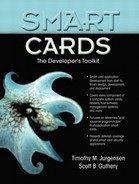The technical groundwork has been laid for wide-spectrum exploitation of smart card technology in both commercial and enterprise venues. Our goal in this book is to provide IT managers, system architects, system analysts, and application developers with the basic information about smart card technology that they need to open the tap on the incredible value stored in this technology.
Information about smart cards and the technical detail needed to harness the technology has historically been very hard to come by. This, more than any other factor, has been the barrier to the use of smart cards. Whereas they once had a unique value offer, smart cards now have many technical substitutes. Belatedly, the smart card industry has realized that either applications carry cards into the mainstream of everyday use or they will join eight-track tapes, monorail trains, cold fusion, magnetic bubbles, and Betamax video in the dustbin of technical curiosities.
A smart card is just a computer. We know how that story plays out. We've seen it in mainframes, mini-computers, desktop computers, and laptops. You have apps and you connect or you die. The smart card will follow the same path.
Some computing device will capture the next and, yet again, more personal level of computing. It will be our avatar on the Internet. It will be our digital wallet. It will be the keeper of our digital persona. The smart card is in the race. It's cheap. It's portable. It's about as secure as you can make a computer that fits in your pocket. And if you're willing to spend the time, it can deliver a surprising amount of performance. Take it out for a spin. See what you think.
The authors would like to express thanks to Schlumberger and to Mobile-Mind respectively for their support in the development of this book. Schlumberger was most gracious in allowing us to discuss and present technical details about their Cryptoflex and Cyberflex Access smart cards and to allow us to use selected graphical material from various Schlumberger sources.
We would especially like to recognize David Corcoran of M.U.S.C.L.E. for his contribution of material to the book and his review of other material in the book. Much of the discussion of Unix, Mac OS, and Linux implementations of smart card stacks in Chapter 7 came from Dave.
We would like to thank Nigel Barnes, Dan Butnaru, Bertrand du Castel, Paul Curtis, Ed Dolph, Susanna Eskola, Olivier Franchi, Gillian Harris, Michael Johnson, Roger Kehr, Ksheerabdhi Krishna, Rune Lindholm, Scott Marks, Gregory Maulion, James McLaughlin, Mike Montgomery, Michael Meyer, Maria Nekam, Neville Pattinson, Jean-Claude Perrin, Joachim Posegga, Renaud Presty, Jean-Francois Rubon, Wim Ton, Jean-Paul Truong, Harald Vogt, and Marc Valderrama for various conversations that contributed to the book and for various reviews of material in the book.
Remaining errors are the sole responsibility of the authors. They would greatly appreciate hearing about them. Opinions expressed are those of one or both of the authors and do not necessarily reflect those of the publisher, Schlumberger, or Mobile-Mind.
Tim Jurgensen[email protected]Scott Guthery[email protected]
